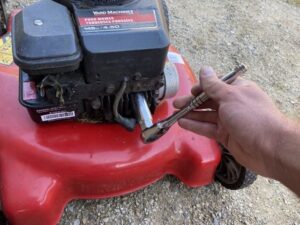
A well-maintained spark plug is the ignition powerhouse of your lawn mower, ensuring a smooth and efficient operation. Over time, spark plugs can become dirty or worn out, affecting the performance of your mower. In this article, we’ll unveil the secrets of spark plugs and guide you through the step-by-step process of checking and replacing the spark plug in your lawn mower.
Step 1: Safety First
Before you begin any maintenance task, prioritize your safety. Make sure the mower is turned off, the spark plug wire is disconnected, and the engine has cooled down completely.
Step 2: Locate the Spark Plug
Identify the spark plug location on your lawn mower. It’s usually situated on the top or side of the engine cylinder.
Step 3: Remove the Spark Plug Wire
Carefully detach the spark plug wire from the spark plug. It’s essential to grip the boot firmly and pull straight off to avoid damaging the wire.
Step 4: Clean the Area
Clean the area surrounding the spark plug using a brush or compressed air. This prevents debris from falling into the combustion chamber when you remove the plug.
Step 5: Remove the Spark Plug
Using a spark plug socket and ratchet, turn the socket counterclockwise to loosen and remove the spark plug from the cylinder head. Be cautious not to drop the plug into the engine.
Step 6: Inspect the Spark Plug
Examine the condition of the spark plug. Look for signs of fouling, such as carbon deposits, oil residue, or excessive wear. If the plug is damaged or heavily fouled, it’s time for a replacement.
Step 7: Gap the New Spark Plug
If you’re installing a new spark plug, ensure the electrode gap matches the manufacturer’s specifications. Use a spark plug gap tool to adjust the gap if necessary.
Step 8: Install the New Spark Plug
Carefully thread the new spark plug into the cylinder head by hand, then use the spark plug socket and ratchet to tighten it. Avoid overtightening, as it may cause damage.
Step 9: Reconnect the Spark Plug Wire
Reattach the spark plug wire to the new spark plug. Give it a gentle tug to ensure it’s securely connected.

Step 10: Test the Mower
Once the spark plug is in place, reconnect any disconnected components, and start your lawn mower. Observe the engine’s performance and listen for any irregularities. A properly installed and functioning spark plug should provide a smooth start and consistent operation.
Regularly checking and replacing your lawn mower’s spark plug can optimize its performance and extend its lifespan. Remember to consult your mower’s manual for specific instructions and recommended spark plug types. With this step-by-step guide, you’ll be equipped to keep your lawn mower running smoothly and effortlessly, ensuring a well-groomed yard every time you mow.
As an Amazon Associate we earn from qualifying purchases through some links in our articles.




